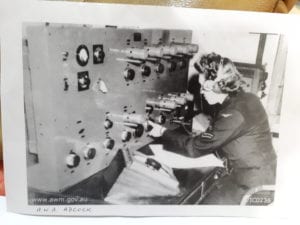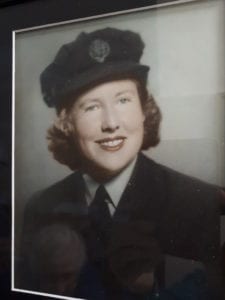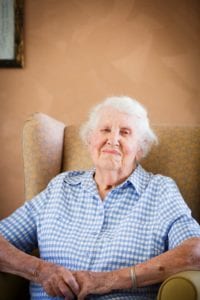In 1941 Mavis Wheeler was one of only six women hand-picked by the Royal Australian Air Force to test their skills as telegraphists. With more and more men required in the Pacific war zone, the RAAF tested the theory that women might be just as capable as men at the exacting and critical task of sending and receiving bearings from aircraft in order to keep them on course. It was a world first in the British Empire at the time and an opportunity to prove that women were more than up to the task…
When I was born in 1921 my father danced around the table: at last, a girl! Four boys and now a daughter! Another son followed and so I grew up with five brothers. We lived in Longueville in a house built in 1888 and from the verandah I watched the Sydney Harbour Bridge being built. It was a wonderful place to spend my young years. I had a friend called Catherine and I used to walk to her house, she wasn’t far away, just down the lane, and we’d play on the swings together. Her uncle Charles used to come out and give us a push on the swing – how I loved being up up up, high in the air. Little did I know, but so did Charles, who later became Sir Charles Kingsford Smith; I wonder what amazing flying machines he was dreaming of while he pushed us two little girls in the fresh air.
The Depression years, however, were awful. Even more devastating was the untimely death of my lovely mother; I was only about 12 or so. Dad sold the house and my little brother and I were billeted out separately to friends’ houses; I think I lived in about seven different places at that time.
After leaving school I became a typist and when war was declared in 1939 I signed up to the Women’s Australian National Service, spending my weekends learning first aid etc. In May 1941 I started attending Fort Street High School after work, four or five nights a week for three hours at a time, to learn Morse Code and in July 1941 I volunteered as a telegraphist with the Women’s Auxiliary Australian Air Force. I had an interview, a medical and waited for the call-up. It was all very exciting. But in those days they thought that women didn’t have the ability to do things that the men were doing, they thought we were temperamentally weak. In October 1941 the Australian Air Force decided they wouldn’t let women join the Air Force. I’d spent so much time learning Morse Code, only to be told I was not suited because of my gender. My father wrote a letter to the Sydney Morning Herald, so enraged was he. Then, of course, the Japanese bombed Pearl Harbour and it was all on. On 31st March 1942 I was called up and sent to the WAAAF training Depot in Toorak, Melbourne. The demand for male Air Force telegraphists overseas increased, leaving a gap here in Australia. This was our chance to show them that we could do it. About 20 of us were interviewed by a board – comprised entirely of men of course – and they picked just six to see how we would go. I was one of the six “experiments”. Number 1 MFDF course. It was such a great opportunity, and unique too, being the only one of its kind in the Empire Air Force at the time. We were posted to Laverton, a RAAF test and repair station, set up in a hut about twenty minutes walk away (to avoid aerial interference). It was exacting and exhausting work, eight hour shifts of intense concentration, but I found it absolutely thrilling.

Photo: Mavis’ friend Beryl working the machines
“In those days they thought that women didn’t have the ability to do things that the men were doing, they thought we were temperamentally weak.”
When I was off duty I’d walk over to the test and repair station and ask “Is anyone taking a flight today? Can I come too?” I flew in Venturas, Lockheads, the Beaufighter which was called The Whispering Death, and Douglases. One time a plane was coming up to Sydney, it was a Volte Vengeance, a fighter plane. I was able to sit in the back seat where the gunner normally sat, I don’t think many people have had that opportunity!
After the war I wanted to travel so a friend and I decided to go to England in 1952. I stayed for five and a half years, working and travelling around the continent. We hitchhiked for the first year with our knapsacks proudly emblazoned with a kangaroo to let people know we were Australian. In places like Holland, Belgium and France we were so well received, always given a good lift and sometimes a meal. We knew that anywhere our troops had been was safe travelling for us.

Photo: Mavis in uniform with the WAAAF, 1943
After five and a half years in England and Europe I sailed for Canada, working in Montreal for 18 months or so. But the call to come home after seven years away came, so home I came by ship, via Hawaii and New Zealand. There they all were, my brothers and my father, to welcome the only woman of the family home. It was a little difficult to settle but I found work and made myself busy. I bought a 1600 Datsun, a racing car, not that I raced it. But I must admit, when I took it to Orange to visit my brothers over the mountains I’d go and if it was the middle of the day, with no traffic on the roads … you could really take off. This was before speed cameras of course.
I moved into RSL LifeCare’s ANZAC Village in Narrabeen in 2004. I got involved in the ex-service women’s group for quite a number of years. I find that if you can make yourself useful it helps everyone including yourself. I like to keep busy and active. I’ve had a good life, a busy life and I’ve got friends all over the world.

Photo: Mavis Wheeler currently lives at RSL ANZAC Village, Narrabeen “The War Vets”
Words: Helen Johnston
Photography: Tim Pascoe
Continue Reading
Discover our Services
Home Care
Retirement Living
Residential Care
Veteran Services
Download a brochure
We'll never share your email address and you can opt out at any time, we promise


